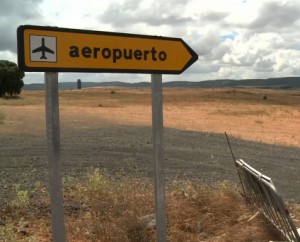Last week, Spanish newspapers reported that a recently busted gang of drug smugglers had planned to buy part of Ciudad Real airport in order to ship cocaine into the country. It was hardly the kind of news that the Castilla-La Mancha authorities would normally have enjoyed hearing, but right now, almost any potential buyer of this huge building with a four-kilometre airstrip will be welcomed with open arms.

The Aeropuerto Central Ciudad Real, as it is known, is now as representative of Spain –particularly 21st century Spain– as the windmills and plains that surround it. Built in 2008, it was, for a time, presented by the local government as a bold way of putting the land of Don Quijote on the map, by taking in the overflow of passengers from Madrid’s Barajas airport, 235 kilometres to the north. It would also be a symbol of modern Spain’s affluence and dedication to infrastructure.
But three years and reportedly €1.1 billion in private investment later, it looks more like an almighty folly. The Socialist regional government spent millions subsidising a handful of international flights per week, promoted the project with advertising campaigns and approved a €140-million guarantee to keep it afloat. But at the end of October, the last commercial flight, manned by Vueling, took off from the airport. The airport’s future is now unsure. It remains open, with staff still employed in the building. Buyers are being sought. But the projected overflow of travellers from Madrid, it transpired, has been taken care of by the capital’s own Terminal 4.
Locals complain about other expensive projects that devour public money but whose benefits are dubious, such as the €6-million centre for sporting excellence in Puertollano, just up the road from Ciudad Real. According to Puertollano residents, for a long time the building stood empty, with little excellence being produced by its huge, expensive walls.
But airports seem to have a peculiar attraction for Spain’s local politicians, who have eagerly built them in recent years in towns and small cities such as Huesca, Castellón, Burgos, Salamanca and Lleida, with another planned for Teruel. Some have already proved their lack of profitability due to a lack of demand, such as Huesca’s, which like that of Ciudad Real has become something akin to a ghost airport.
Most of these projects, like some high-speed AVE routes to out-of-the-way destinations, coincided with Spain’s boom years. The decade-long bonanza that started at the end of the 1990s and was driven by construction ensured deep pockets not just for the central government, but also the regional governments.
It’s hard to argue with the benefits of this spending. Spain has a superb transport system, particularly its rail links. Puertollano’s centre of excellence might be easy to sniff at, but heavy investment in infrastructure is cited as one of the main reasons why Spain’s footballers and other athletes currently dominate much of world sport.
Basic services suffer
And yet, clearly something was amiss. Since taking power in the Castilla-La Mancha region in the spring, the new Popular Party administration has pledged to slash spending on health by €400 million. Teachers in the region are angry at having to take pay cuts and work longer hours. Castilla-La Mancha’s government says it is now handling a deficit worth around 9 percent of its GDP – compared to the 1.3-percent target the central government had set the country’s regions.
“Regions in Spain have the capacity to spend a lot, because health and education, among other things, belong to them,” José Antonio Herce, of Analistas Financieros Internacionales consultancy, told Iberosphere.
“(The regions) have to spend a lot of money because they oversee these very important social programs, but they don’t have the capacity – or they don’t want to use it where they have it – to charge taxes on their populations. It’s much easier to spend than to tax.”
This gap between local authorities’ freedom to spend and their lack of responsibility when it comes to raising funds seems to be at the heart of the problem. And as we contemplate what many observers fear may be a lost decade or so for the Spanish economy, one chilling legacy of the country’s recent boom and bust comes sharply into focus: towns, big and small, with state-of-the-art sports halls, cultural centres, train stations and even airports; and brutal cuts to the most basic services.
Leave a Reply
You must be logged in to post a comment.